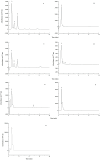Metabolic Engineering of Escherichia coli for Producing Astaxanthin as the Predominant Carotenoid
- PMID: 28937591
- PMCID: PMC5666404
- DOI: 10.3390/md15100296
Metabolic Engineering of Escherichia coli for Producing Astaxanthin as the Predominant Carotenoid
Abstract
Astaxanthin is a carotenoid of significant commercial value due to its superior antioxidant potential and wide applications in the aquaculture, food, cosmetic and pharmaceutical industries. A higher ratio of astaxanthin to the total carotenoids is required for efficient astaxanthin production. β-Carotene ketolase and hydroxylase play important roles in astaxanthin production. We first compared the conversion efficiency to astaxanthin in several β-carotene ketolases from Brevundimonas sp. SD212, Sphingomonas sp. DC18, Paracoccus sp. PC1, P. sp. N81106 and Chlamydomonas reinhardtii with the recombinant Escherichia coli cells that synthesize zeaxanthin due to the presence of the Pantoea ananatis crtEBIYZ. The B. sp. SD212 crtW and P. ananatis crtZ genes are the best combination for astaxanthin production. After balancing the activities of β-carotene ketolase and hydroxylase, an E. coli ASTA-1 that carries neither a plasmid nor an antibiotic marker was constructed to produce astaxanthin as the predominant carotenoid (96.6%) with a specific content of 7.4 ± 0.3 mg/g DCW without an addition of inducer.
Keywords: Escherichia coli; astaxanthin; metabolic engineering; β-carotene hydroxylase; β-carotene ketolase.
Conflict of interest statement
The authors declare no conflicts of interest.
Figures


Similar articles
-
Engineering CrtW and CrtZ for improving biosynthesis of astaxanthin in Escherichia coli.Chin J Nat Med. 2020 Sep;18(9):666-676. doi: 10.1016/S1875-5364(20)60005-X. Chin J Nat Med. 2020. PMID: 32928510
-
Characterization of bacterial beta-carotene 3,3'-hydroxylases, CrtZ, and P450 in astaxanthin biosynthetic pathway and adonirubin production by gene combination in Escherichia coli.Appl Microbiol Biotechnol. 2006 Oct;72(6):1238-46. doi: 10.1007/s00253-006-0426-2. Epub 2006 Apr 14. Appl Microbiol Biotechnol. 2006. PMID: 16614859
-
Engineering of a plasmid-free Escherichia coli strain for improved in vivo biosynthesis of astaxanthin.Microb Cell Fact. 2011 Apr 26;10:29. doi: 10.1186/1475-2859-10-29. Microb Cell Fact. 2011. PMID: 21521516 Free PMC article.
-
Carotenoid β-ring hydroxylase and ketolase from marine bacteria-promiscuous enzymes for synthesizing functional xanthophylls.Mar Drugs. 2011;9(5):757-771. doi: 10.3390/md9050757. Epub 2011 May 6. Mar Drugs. 2011. PMID: 21673887 Free PMC article. Review.
-
Sustainable production of astaxanthin in microorganisms: the past, present, and future.Crit Rev Food Sci Nutr. 2023;63(30):10239-10255. doi: 10.1080/10408398.2022.2080176. Epub 2022 Jun 13. Crit Rev Food Sci Nutr. 2023. PMID: 35694786 Review.
Cited by
-
Enhancing astaxanthin biosynthesis and pathway expansion towards glycosylated C40 carotenoids by Corynebacterium glutamicum.Sci Rep. 2024 Apr 6;14(1):8081. doi: 10.1038/s41598-024-58700-9. Sci Rep. 2024. PMID: 38582923 Free PMC article.
-
Response surface-based media optimization for astaxanthin production in Corynebacterium glutamicum.Front Bioeng Biotechnol. 2025 Mar 11;13:1516522. doi: 10.3389/fbioe.2025.1516522. eCollection 2025. Front Bioeng Biotechnol. 2025. PMID: 40134774 Free PMC article.
-
Astaxanthin overproduction in yeast by strain engineering and new gene target uncovering.Biotechnol Biofuels. 2018 Aug 23;11:230. doi: 10.1186/s13068-018-1227-4. eCollection 2018. Biotechnol Biofuels. 2018. PMID: 30159030 Free PMC article.
-
Construction of an alternative glycerol-utilization pathway for improved β-carotene production in Escherichia coli.J Ind Microbiol Biotechnol. 2018 Aug;45(8):697-705. doi: 10.1007/s10295-018-2045-1. Epub 2018 May 11. J Ind Microbiol Biotechnol. 2018. PMID: 29752566
-
Assessment of Expression Cassettes and Culture Media for Different Escherichia coli Strains to Produce Astaxanthin.Nat Prod Bioprospect. 2018 Oct;8(5):397-403. doi: 10.1007/s13659-018-0172-z. Epub 2018 Jun 6. Nat Prod Bioprospect. 2018. PMID: 29876754 Free PMC article.
References
-
- Lee P.C., Schmidt-Dannert C. Metabolic engineering towards biotechnological production of carotenoids in microorganisms. Appl. Microbiol. Biotechnol. 2002;60:1–11. - PubMed
MeSH terms
Substances
LinkOut - more resources
Full Text Sources
Other Literature Sources
Research Materials
Miscellaneous

